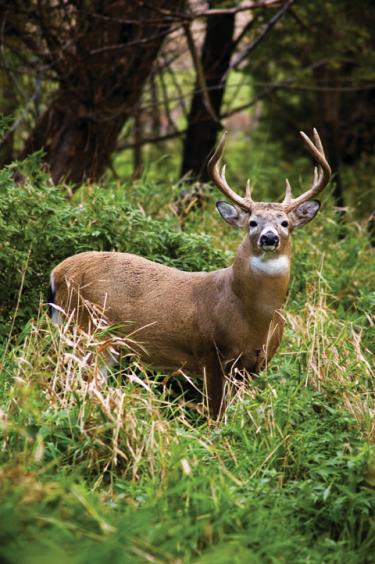White-tailed Deer
The white-tailed deer (Odocoileus virginianus), with its stark white belly and buttocks, is the most popular and plentiful game species in the U.S, east of the Rockies. West of the Rockies Black-tailed deer and mule deer are common.
With a little foresight and planning, it’s possible to attract and maintain a healthy deer herd— complete with mature, trophy-class bucks—on relatively small woodland tracts. The key to success is providing for the herd’s four basic needs—food, water, cover and space—throughout the year, by actively managing your woodland with deer in mind.
Why is active management so important? Without taking a hands-on approach, woodlands actually tend to evolve into low-quality wildlife habitats. These overgrown forests and grassy meadows just won’t meet a herd’s needs.
If you’re lucky enough own a piece of deer country, here’s what you need to know.
The Basics
A white-tailed deer’s specific needs may vary by region but their habitat requirements are universal. Use the following information as a starting point to caring for deer, then modify it to suit your local environment.
- Food: White-tailed deer are herbivores that browse for their food. They mostly eat browse (leaves, twigs, shoots of woody plants and vines, hard and soft mast) and forbs (weeds and other broadleaf flowering plants), as well as grass, lichens, mushrooms and cultivated foods. In general, deer prefer green and succulent herbaceous plants over dormant, dry plants and coniferous browse over hardwood browse. They will also consume agricultural crops, especially corn, as well as native fruits and nuts year-round. A whitetail’s food preferences change with the seasons, depending on its nutritional needs. For example, in spring, deer are recovering from winter shortages and the rut so they need food that’s high in protein.
- Water: Deer maintain much of the water they need to survive from the foods they consume, but they will also drink free water from ponds, creeks, river and springs.
- Cover: Cover protects deer from predators and the elements while they’re bedding, feeding, loafing or travelling. Generally, white-tailed deer prefer wooded areas intermixed with openings. So areas without woody vegetation are not ideal, nor are wooded areas completely covered with timber.
- Space: A deer’s range varies greatly from 60 to 1600 acres, annually, and depends on its age and sex, as well as its habitat.
How can I get more tips?
It’s simple! Enter your email below.

